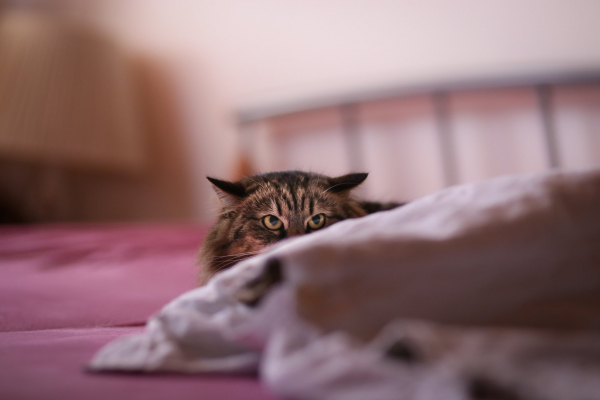Dog Puller. Hra a zároveň trénink pro všechny druhy psů
Další z možných sportů, při kterém svého psa hrou můžete zároveň i intenzivně procvičit, je Dog Puller. Cvičit jej můžete se všemi druhy psů nehledě na velikost či věkovou kategorii.
I have already written about dogs and how they (don’t) feel pain. So let’s look at cats. It is often not very simple to recognize. But the early recognition of the problem is important for their health and well-being.


I have already written about dogs and how they (don’t) feel pain. So let’s look at cats. It is often not very simple to recognize. But the early recognition of the problem is important for their health and well-being.
As I have already written in the article about how dogs feel pain, the animals were in the past considered to be some third-rate creatures controlled by their instincts and therefore their pain was not taken into account. René Descartes took the view that the animals have been created on Earth for the benefit of man. That they do not have a soul and the people are not guilty in terms of morals when they kill animals. This proposition also got into biology and the scientists used it to entitle themselves to treat animals unethically and cruelly.
But animals are not machines, their nerve system has developed the same way ours has and regarding the evolution, the ability to feel pain increases prospects for survival of the individual and it helps to avoid the sources of danger.
Of course, today we already know (at least the majority of us) that animals can feel pain as well as we do and we usually care about that. The problem may be to notice the pain of the animal.
Cats, just like dogs, hide their pain. And they are supposed to be even better at this. So it is up to us to observe the changes in their behaviour. Every cat is different and has its own specific habits and therefore we need to be attentive to any minor deviations from its normal behaviour.
Here is a list of certain situations that normally indicate that a cat feels pain and perhaps there could be something wrong with her:
If you have observed any of the things above and you worry, it is certainly good to visit a vet. Prevention and check-up is always a better choice than to ignore it and do not think it’s important. You can not only help your cat not to suffer from pain but you can also avoid its early death or consequences for life.


Další z možných sportů, při kterém svého psa hrou můžete zároveň i intenzivně procvičit, je Dog Puller. Cvičit jej můžete se všemi druhy psů nehledě na velikost či věkovou kategorii.


Tak jako nám, ani našim zvířecím mazlíčkům se nevyhýbají srdeční choroby. A jejich onemocnění je čím dál častější. Nejde pouze o přešlechtění plemen, ale důležitou roli hraje i prostředí, ve kterém žijí. Správnou prevencí je hlavně dobrá životospráva a...


Péče o zvířata a jejich ochrana se staly jedním z hlavních celospolečenských témat. V dnešní online době se ani není čemu divit. Týrání a nepráví páchaného na zvířatech je plný internet, tedy i když se nás tento problém zpočátku nemusí týkat, být...


V dnešní době se kočky čím dál častěji stávají členy našich domácností. Tomuto trendu se přizpůsobují i výrobci kočičích záchodů. Ty mohou kočkám při jejich každodenní potřebě dopřát větší pohodlí. Z pohledu majitelů výrobci kladou větší důraz i na...


Lov a pohyb. Miluje-li pes obě tyto aktivity, pak je pro něj coursing jako strvořený. Tento terénní dostih je založen právě na touze psa chytit svoji kořist.


Kočka je dokonalým nástrojem pro lov. Vděčí za to desítkám let evoluce. Zatímco u psů byly jejich tělesné znaky zdůrazněny nebo potlačeny, kočkám zůstaly krom několika výjimek jejich hlavní rysy stavby těla nezměněny. Krom smyslů je právě stavba těla...


Ať jsme v prevenci sebedůkladnější, může nastat situace, kdy se pes nebo kočka k pro ně jedovaté věci dostane, ať už naší nepozorností, nebo cizím zaviněním. Proto není od věci se na možnost otravy připravit a vědět nejen, co v takové situaci dělat,...


Jsem milovnicí koček. Fascinují mě svou ladností, hravostí i velkou hrdostí. Na konci jara jsem zapátrala po zajímavostech z kočičí historie a kroky mě zavedly až na dálný Východ k Maneki Neko, kočce která lidem nosí štěstí a bohatství. Podobně jako v...


Příběh udatného Bamsyho se začal psát v norském Oslu v roce 1937. Jako štěně ho koupil lodní kapitán Erling Hafto, který z něj začal vychovávat pravého námořníka. Už od útlého štěněčího věku se tak Bamsy plavil na lodích a seznamoval se s životem na...


Hned v úvodu musím zdůraznit, že každý pes je jiný. Každý prožívá nervozitu jinak, a tudíž ji i jinak projevuje. Někteří se bojí, jiní se hned ženou do boje. Je úkolem pána poznat, co jeho pes zrovna cítí, a pokud možno i předvídat, jaká situace mu...


Na tom, jestli správně vytáhnete klíště z psího nebo kočičího kožichu, může záviset, jestli se zvíře nakazí lymskou boreliózou nebo jiným zákeřným onemocněním přenášeným klíšťaty. Máte na to tu správnou techniku a pomůcky?


Stejně jako u lidí, je také u psů borelióza velmi závažným onemocněním. Nakažených je v České republice odhadem 20 % klíšťat. A protože i přes použití antiparazitik může váš pes sem tam nějaké to klíště chytit, je dobré vědět, jak se toto bakteriální...